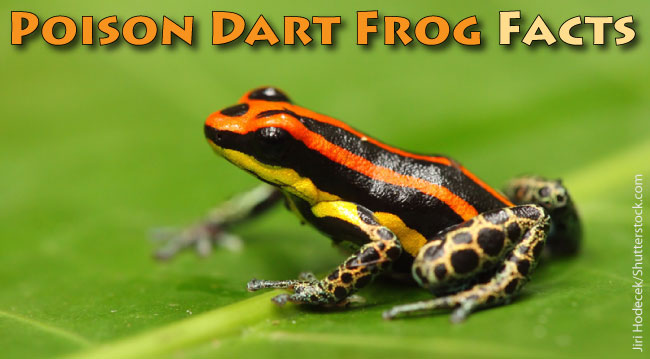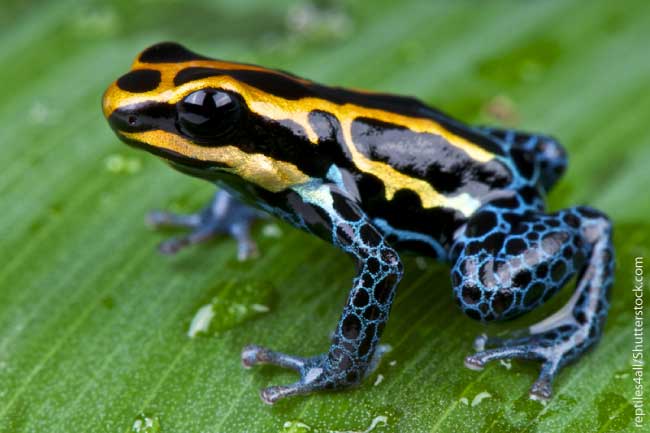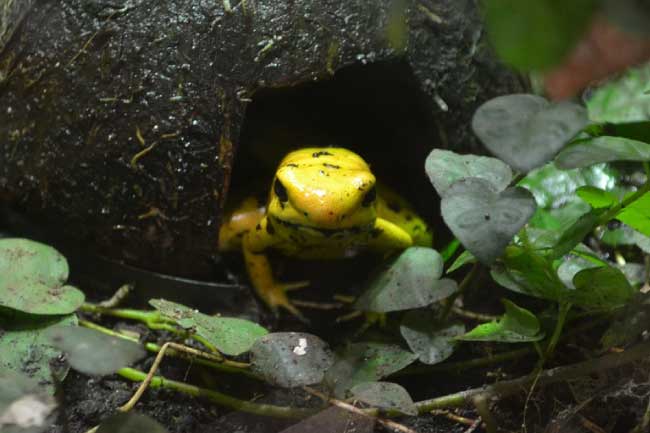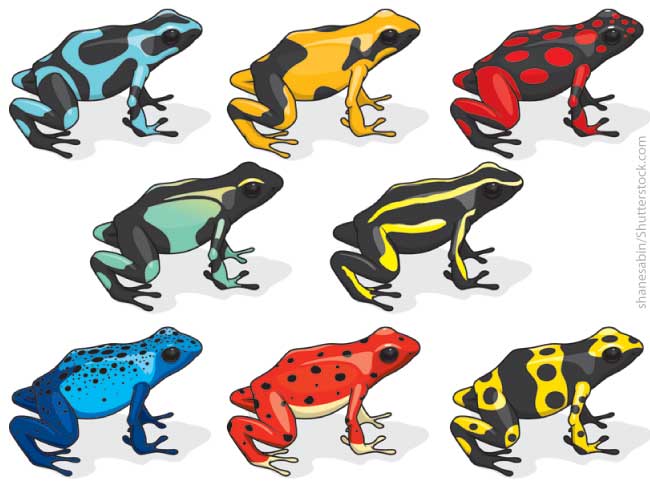A creature’s size is not always an indicator of how dangerous it is. Poison dart frogs may be small, but they are among the most poisonous of all living creatures! This article contains many more poison dart frog facts, and is part of our Rainforest Animals series.
Poison Dart Frog Facts
The poison dart frog is Native to Central and South American rainforests. There are nearly 200 species of poison dart frog, most of which are brightly colored. This coloration is not just for show: it warns potential predators that the frogs are poisonous.
Some species of poison dart frog are among the most poisonous of all living creatures. However, poison dart frog species vary in toxicity, and few are deadly.
Poison dart frogs range in size from .4-2.4 inches (1-6 cm) in length (the smallest are about the size of a thumbnail).
The brightly-colored skins of the poison dart frogs serve as a warning to other rainforest creatures. They know that when they see the poison dart frog’s vibrant red, blue, orange, yellow, or green hue, they are dealing with a meal that is potentially lethal. The poison dart frog’s poison is secreted from skin glands, and covers the animal’s skin.
Just one lick of a poison dart frog could be fatal, and if the frog’s poison doesn’t kill the predator, it can cause nausea, swelling or paralysis. Any animal that survives the poison is unlikely to forget its effects – and will therefore avoid that species of frog in the future.
Golden Poison Dart Frog
The deadliest poison comes from the feared golden poison dart frog. Found only in Colombia, South America, one frog carries enough poison to kill 10 grown men! It only takes two micrograms (.000002 of a gram) to kill one person.
The golden poison dart frog has the rather scary-sounding scientific name of Phyllobates terribilis.
How Poison Dart Frogs Got Their Name
Hunters capture poison dart frogs and use the frog’s poison on the tips of their blow darts.
After capturing the frogs, there are two ways in which the hunters extract the poison. Using the first method, the hunters hold the frog with a stick, which scares the animal into secreting the poison. The hunters then dip their darts into the secreted poison. The frogs are then released back into the forest.
Using the second method, they hold the frog over a fire, causing the frog to emit a yellow froth that the hunters rub their darts in. The hunters then drop the frog into the fire to die.
Poison Dart Frog Facts: The Poison
Poison dart frogs that are kept and fed in captivity are often not as poisonous as those that live in the wild. Scientists think that this is because the poison dart frogs don’t actually make their own poison, but that it comes from chemicals in the frog’s natural food.
Poison Dart Frog Life Cycle
When it’s time to mate, the male frog will call out to attract females. The female will approach and rub her nose on his. Then, they do a little dance with each other. After this, the male leads the female to a leafy place on the ground, where she will lay up to 40 eggs in a jello-like (gelatinous) substance and he will fertilize them.
The eggs need to stay moist, so the parents will take turns getting their own skin wet and sitting on the eggs, or they will urinate on the eggs. The eggs are non-poisonous, and in danger of being eaten by other frogs, birds, or other animals and insects. The male frog returns often to check on them.
After 2-4 weeks, the tadpoles hatch and swim up on the male frog’s back and head. He then carries them to their new home. This is often a plant with large, bowl-like leaves that can hold water.
In the video below, you can see a poison dart frog carrying its tadpoles.
Once the tadpoles are in the water, the female frog brings them unfertilized eggs to eat, and they also feed on the algae in the water. As tadpoles, the poison dart frogs’ colors are dull and at this stage they still aren't poisonous. However, they grow up fast, and at 6-12 weeks they reach maturity, with their bright colors fully developed. Poison dart frogs can live up to six years in the wild.
10 Poison Dart Frog Facts
- As well as in the rainforests, poison dart frogs are also found on a few Hawaiian Islands.
- Generally, the brighter their color, the more poisonous they are.
- In zoos, poison dart frogs are fed crickets.
- poison dart frogs have excellent eyesight.
- Poison dart frogs can live up to 10 years in captivity.
- Some species, such as the Blue Poison Dart Frog, are endangered. This is due to deforestation and the pet market.
- The poison-dipped darts of hunters can be dried and stored for 10 years without losing their potency.
- poison dart frogs are in the scientific family Dendrobatidae.
- Only frogs in the genus Phyllobates are used by hunters for poisoning their darts. This genus includes the golden poison dart frog (Phyllobates terribilis).
- Unlike most tropical frogs, which are nocturnal (active at night), poison dart frogs are diurnal (active during the day).
We hope that you have enjoyed reading these poison dart frog facts. Learn about other rainforest animals here.





